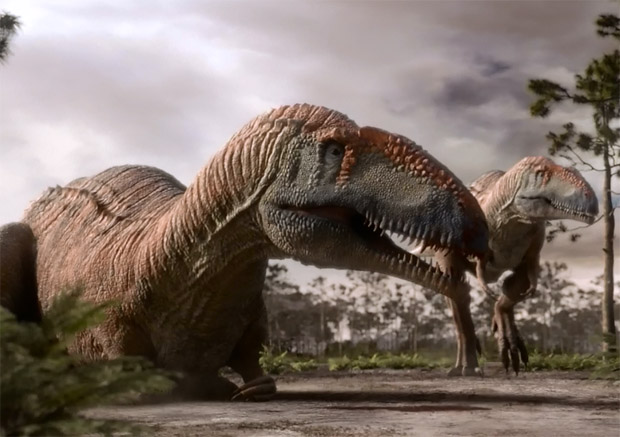Post by dinosauria101 on Aug 28, 2019 16:57:58 GMT 5
Daspletosaurus torosus (pack of 2)
While very large by the standard of modern predators, Daspletosaurus was not the largest tyrannosaurid. Adults could reach a length of 8–9 meters (26–30 ft) from snout to tail. Mass estimates have centered on 2.5 t (2.5 long tons; 2.8 short tons), but have ranged between 1.8 and 3.8 t (1.8 and 3.7 long tons; 2.0 and 4.2 short tons). Daspletosaurus had a massive skull that could reach more than 1 meter (3.3 ft) in length. The bones were heavily constructed and some, including the nasal bones on top of the snout, were fused for strength. Large fenestrae (openings) in the skull reduced its weight. An adult Daspletosaurus was armed with about six dozen teeth that were very long but oval in cross section rather than blade-like. Unlike its other teeth, those in the premaxilla at the end of the upper jaw had a D-shaped cross section, an example of heterodonty always seen in tyrannosaurids. Unique skull features included the rough outer surface of the maxilla (upper jaw bone) and the pronounced crests around the eyes on the lacrimal, postorbital, and jugal bones. The orbit (eye socket) was a tall oval, somewhere in between the circular shape seen in Gorgosaurus and the 'keyhole' shape of Tyrannosaurus.

Mapusaurus roseae
Mapusaurus ("Earth lizard") was a giant carnosaurian, Carcharodontosaurid dinosaur from the early Late Cretaceous (late Cenomanian to early Turonian stage) of what is now Argentina and possibly Chile. It was roughly similar in size to its close relative Giganotosaurus, averaging about 12.4 meters and 7 tonnes and getting to 13.6 meters long and 8.5 tonnes at maximum. The longest individual for which Coria and Currie (2006) provided a concrete estimate in Table 1 (apendix lll) is the animal to which femur MCF-PVPH-208.203 belonged; this individual is estimated as 10.2 metres (33 ft) long, but it is a juvenile. The fossil remains of Mapusaurus were discovered in a bone bed containing at least seven individuals of various growth stages. Coria and Currie speculated that this may represent a long term, possibly coincidental accumulation of carcasses (some sort of predator trap) and may provide clues about Mapusaurus behavior. Other known theropod bone beds include the Allosaurus-dominated Cleveland-Lloyd Dinosaur Quarry of Utah, an Albertosaurus bone bed from Alberta and a Daspletosaurus bone bed from Montana. Paleontologist Rodolfo Coria, of the Museo Carmen Funes, contrary to his published article, repeated in a press-conference earlier suggestions that this congregation of fossil bones may indicate that Mapusaurus hunted in groups and worked together to take down large prey, such as the immense sauropod Argentinosaurus. If so, this would be the first substantive evidence of gregarious behavior by large theropods other than Tyrannosaurus, although whether they might have hunted in organized packs (as wolves do) or simply attacked in a mob, is unknown.

Credit to Wikipedia
While very large by the standard of modern predators, Daspletosaurus was not the largest tyrannosaurid. Adults could reach a length of 8–9 meters (26–30 ft) from snout to tail. Mass estimates have centered on 2.5 t (2.5 long tons; 2.8 short tons), but have ranged between 1.8 and 3.8 t (1.8 and 3.7 long tons; 2.0 and 4.2 short tons). Daspletosaurus had a massive skull that could reach more than 1 meter (3.3 ft) in length. The bones were heavily constructed and some, including the nasal bones on top of the snout, were fused for strength. Large fenestrae (openings) in the skull reduced its weight. An adult Daspletosaurus was armed with about six dozen teeth that were very long but oval in cross section rather than blade-like. Unlike its other teeth, those in the premaxilla at the end of the upper jaw had a D-shaped cross section, an example of heterodonty always seen in tyrannosaurids. Unique skull features included the rough outer surface of the maxilla (upper jaw bone) and the pronounced crests around the eyes on the lacrimal, postorbital, and jugal bones. The orbit (eye socket) was a tall oval, somewhere in between the circular shape seen in Gorgosaurus and the 'keyhole' shape of Tyrannosaurus.

Mapusaurus roseae
Mapusaurus ("Earth lizard") was a giant carnosaurian, Carcharodontosaurid dinosaur from the early Late Cretaceous (late Cenomanian to early Turonian stage) of what is now Argentina and possibly Chile. It was roughly similar in size to its close relative Giganotosaurus, averaging about 12.4 meters and 7 tonnes and getting to 13.6 meters long and 8.5 tonnes at maximum. The longest individual for which Coria and Currie (2006) provided a concrete estimate in Table 1 (apendix lll) is the animal to which femur MCF-PVPH-208.203 belonged; this individual is estimated as 10.2 metres (33 ft) long, but it is a juvenile. The fossil remains of Mapusaurus were discovered in a bone bed containing at least seven individuals of various growth stages. Coria and Currie speculated that this may represent a long term, possibly coincidental accumulation of carcasses (some sort of predator trap) and may provide clues about Mapusaurus behavior. Other known theropod bone beds include the Allosaurus-dominated Cleveland-Lloyd Dinosaur Quarry of Utah, an Albertosaurus bone bed from Alberta and a Daspletosaurus bone bed from Montana. Paleontologist Rodolfo Coria, of the Museo Carmen Funes, contrary to his published article, repeated in a press-conference earlier suggestions that this congregation of fossil bones may indicate that Mapusaurus hunted in groups and worked together to take down large prey, such as the immense sauropod Argentinosaurus. If so, this would be the first substantive evidence of gregarious behavior by large theropods other than Tyrannosaurus, although whether they might have hunted in organized packs (as wolves do) or simply attacked in a mob, is unknown.

Credit to Wikipedia





